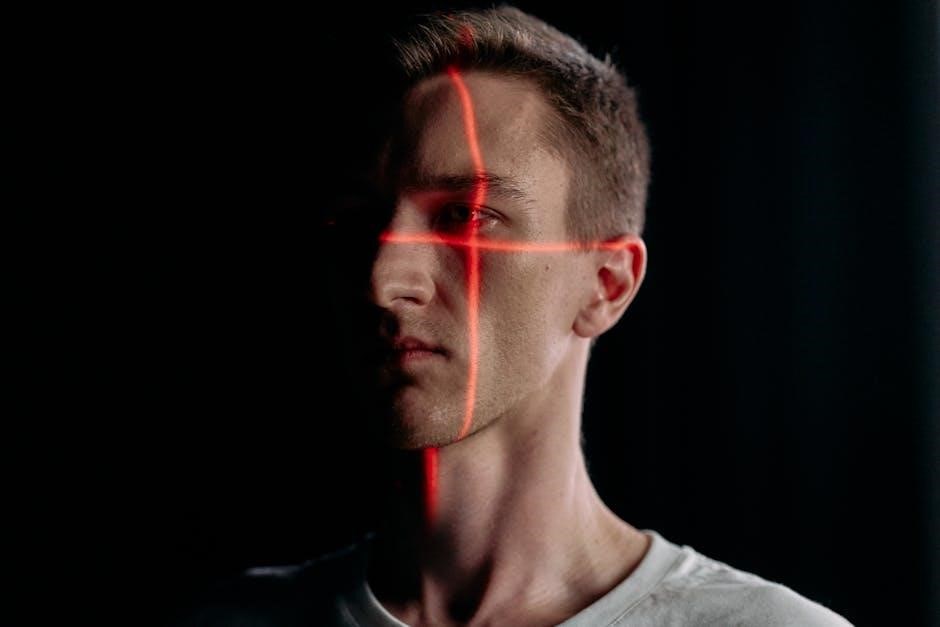Light transport simulation is a fundamental technique in rendering, enabling realistic image synthesis by tracking light paths within scenes. Focal path guiding enhances this process by intelligently sampling paths.
1.1 Definition and Importance of Light Transport Simulation
Light transport simulation is a computational method that models how light interacts with objects in a scene, enabling accurate image synthesis. It is crucial for generating realistic visuals in computer graphics, as it accounts for light emission, scattering, and absorption. By simulating these interactions, it ensures visually coherent and physically accurate results, making it indispensable for applications requiring photorealism and efficiency in rendering complex environments.
1.2 Applications in Computer Graphics and Beyond
Light transport simulation is pivotal in computer graphics for generating photorealistic imagery, enabling real-time rendering, and enhancing virtual worlds. It powers applications like film production, gaming, and architectural visualization, ensuring immersive and lifelike environments. Beyond graphics, it aids in scientific simulations, optical design, and virtual prototyping, making it a cornerstone for both creative and technical advancements across diverse industries.
Understanding Focal Path Guiding
Focal path guiding is a method enhancing light transport simulation by intelligently sampling light paths, improving efficiency and robustness in rendering complex scenes.
2.1 Definition and Basic Principles
Focal path guiding is an advanced rendering technique that optimizes light transport simulation by intelligently guiding light paths through scenes. It focuses on identifying and sampling paths that significantly contribute to the final image, reducing noise and improving efficiency. By leveraging path-tracing algorithms and importance-driven sampling, it ensures accurate and efficient rendering of complex lighting scenarios in virtual environments.
2.2 Historical Development and Evolution
Focal path guiding evolved from early path-tracing methods, with researchers introducing intelligent sampling techniques to reduce noise. Inspired by guided unidirectional path tracing, it advanced through community contributions and algorithmic refinements. The integration with Mitsuba and recursive path tracers marked significant milestones, enhancing efficiency and realism in light transport simulation across various rendering applications.
Theoretical Foundations of Focal Path Guiding
Focal path guiding builds on principles of path-tracing algorithms, leveraging mathematical formulations to construct light paths efficiently. It emphasizes controlling light propagation through scenes for accurate simulations.
3.1 Key Concepts in Path-Tracing Algorithms
Path-tracing algorithms simulate light transport by casting rays from a camera, interacting with scene surfaces, and accumulating contributions. They rely on Monte Carlo integration to estimate radiance at each point. Key concepts include recursive ray tracing, importance sampling, and handling of specular and diffuse reflections. These techniques ensure accurate light propagation modeling, enabling realistic scene rendering while addressing challenges like variance reduction and computational efficiency.
3.2 Mathematical Formulation of Light Path Construction
The mathematical foundation of light path construction involves solving integral equations that describe light transport; Path tracing approximates these integrals by casting rays and accumulating contributions. The process uses Monte Carlo methods to sample paths, while bidirectional path tracing connects light sources and cameras through scattering events. Importance sampling optimizes path selection, reducing variance and improving efficiency in simulating complex light interactions.
Algorithmic Implementation of Focal Path Guiding
Focal path guiding integrates with recursive path tracers, enhancing efficiency by focusing samples on critical light paths. Its implementation leverages frameworks like Mitsuba for robust and scalable rendering solutions.
4.1 Recursive Path Tracing and Its Role
Recursive path tracing forms the core of focal path guiding, iteratively sampling light paths to reduce variance. It integrates with Mitsuba, enhancing rendering efficiency by focusing on high-contribution paths and improving convergence. This approach ensures accurate and robust light transport simulation, making it essential for photorealistic imagery and complex scenes.
4.2 The Role of Mitsuba in Focal Path Guiding
Mitsuba, a versatile rendering framework, plays a pivotal role in implementing focal path guiding. Its flexible architecture allows seamless integration of the algorithm into recursive path tracers. By separating the guided path tracer and visualization tools, Mitsuba enables efficient light transport simulation. The use of nanogui and CMake build systems further enhances its robustness, making it a cornerstone for advancing focal path guiding techniques.
Performance and Efficiency in Focal Path Guiding
Focal path guiding enhances rendering efficiency by reducing variance in light path sampling. Robust techniques ensure accurate results while maintaining computational simplicity and speed.
5.1 Reducing Variance in Light Path Sampling
Focal path guiding minimizes variance in light path sampling by prioritizing high-contribution paths. This adaptive approach reduces noise and improves convergence, enhancing overall rendering efficiency and accuracy.
5.2 Robustness and Unbiased Techniques
Focal path guiding employs robust, unbiased techniques to ensure accurate light transport simulation. By maintaining simplicity in implementation, it achieves efficient path construction while avoiding sampling bias, ensuring reliable results across diverse scenes and lighting conditions.
Applications of Focal Path Guiding
Focal path guiding enhances real-time rendering, virtual world creation, and photorealistic imagery, offering efficient light transport solutions across diverse applications in computer graphics and simulation.
6.1 Real-Time Rendering and Visualization
Focal path guiding significantly enhances real-time rendering by reducing noise and improving convergence in complex scenes. It enables efficient visualization of photorealistic imagery, leveraging frame rates for smooth interactivity. This technique is particularly valuable in applications requiring high-performance rendering, such as virtual world construction and immersive simulations, where detailed environments are rendered at high speeds while maintaining visual fidelity and clarity.
6.2 Virtual Worlds and Photorealistic Imagery
Focal path guiding is instrumental in creating immersive virtual worlds by accurately simulating complex light interactions. It enhances photorealistic imagery by reducing noise and improving sampling efficiency, particularly in scenes with intricate geometries and materials. This technique is crucial for generating high-fidelity visuals, enabling detailed environments and realistic lighting effects that elevate the quality of virtual world construction and immersive simulations.
Challenges and Limitations
Focal path guiding faces challenges in handling complex scenes with multiple specular chains and balancing algorithmic simplicity with robust performance, requiring advanced optimization techniques for efficiency.
7.1 Handling Complex Scenes and Specular Chains
Focal path guiding struggles with intricate scenes featuring numerous specular chains, where light reflects multiple times. These scenarios increase variance, making it harder to sample paths efficiently. Advanced algorithms are required to manage such complexity while maintaining unbiased results, ensuring accurate and efficient light transport simulation in these challenging environments.
7.2 Balancing Algorithmic Simplicity and Robustness
Focal path guiding must balance simplicity to maintain efficiency with robustness to handle diverse light transport scenarios. While simplicity ensures ease of implementation and computational speed, robustness is critical for accurate rendering across complex scenes. Techniques like adaptive sampling and smart path prioritization help achieve this balance, enabling reliable performance without sacrificing algorithmic clarity or efficiency in various rendering environments.
Future Directions and Research Opportunities
Future research focuses on advancing focal path guiding algorithms, exploring real-time applications, and integrating with emerging rendering techniques to enhance photorealism and efficiency in complex environments.
8.1 Emerging Trends in Path-Guiding Algorithms
Emerging trends in path-guiding algorithms include machine learning integration for adaptive sampling, real-time applications in virtual worlds, and hybrid approaches combining focal path guiding with advanced rendering techniques. These innovations aim to enhance efficiency, reduce variance, and improve photorealism in complex scenes, leveraging cutting-edge technologies to push the boundaries of light transport simulation.
8.2 Integrating Focal Path Guiding with Advanced Rendering Techniques
Integrating focal path guiding with advanced rendering techniques enhances efficiency and realism. By combining it with methods like recursive path tracing and Mitsuba, scenes with complex specular chains are rendered more accurately. This integration reduces variance and noise, enabling high-quality, unbiased results. It also supports real-time applications, making it a versatile tool for both photorealistic imagery and interactive visualizations, advancing light transport simulation capabilities significantly.
Tools and Resources for Implementation
Essential tools like nanogui and CMake facilitate focal path guiding implementation. Open-source repositories provide accessible frameworks and community-driven solutions for developers.
9.1 Nanogui and CMake Build Systems
Nanogui and CMake are pivotal in implementing focal path guiding. Nanogui enables efficient visualization tools, while CMake streamlines the build process, ensuring cross-platform compatibility and robust project management. These tools facilitate seamless integration of path-tracing algorithms, enhancing development efficiency and maintaining code consistency across different environments.
9.2 Open-Source Repositories and Community Contributions
Open-source repositories play a crucial role in advancing focal path guiding by providing accessible implementations and fostering collaboration among developers. Community contributions enable the continuous refinement of algorithms, incorporating diverse expertise and accelerating innovation in light transport simulation. These repositories offer transparent access to tools and techniques, promoting widespread adoption and further development of focal path guiding methods effectively.
Case Studies and Practical Examples
Case studies showcase focal path guiding’s implementation in real-world graphics and academic research, highlighting its effectiveness in enhancing light transport simulation through practical examples.
10.1 Real-World Applications in Computer Graphics
Focal path guiding is widely used in film, gaming, and virtual reality to enhance rendering efficiency. It integrates with tools like Mitsuba and nanogui, reducing variance in complex scenes. Real-world applications include photorealistic imagery, virtual world construction, and real-time visualization, enabling faster and more accurate light transport simulation in various industries.
10.2 Successful Implementations in Academic Research
Focal path guiding has been successfully implemented in academic research to enhance light transport simulation efficiency. Studies demonstrate its effectiveness in reducing variance and improving rendering accuracy. Open-source tools like Mitsuba have enabled researchers to share and build upon implementations, fostering collaboration and advancing the field of computer graphics.
Comparison with Other Path-Guiding Techniques
Focal path guiding offers unique advantages in handling complex light paths, reducing variance, and improving efficiency compared to other techniques like guided unidirectional path tracing;
11.1 Guided Unidirectional Path Tracing
Guided unidirectional path tracing uses intelligent sampling strategies to reduce variance in light transport simulation. It focuses on constructing paths in a single direction, enhancing efficiency in complex scenes. Unlike focal path guiding, it emphasizes unidirectional traversal, often integrated with existing algorithms like Mitsuba. This technique is particularly effective for scenes with specular chains, offering robust performance while maintaining simplicity.
11;2 Alternative Methods for Light Path Construction
Beyond focal path guiding, alternative methods like bidirectional path tracing and Metropolis light transport offer distinct approaches. Bidirectional tracing connects light sources and cameras, reducing variance in complex scenes. Photon mapping and progressive photon mapping store light paths for efficient rendering. These techniques, while differing from focal guiding, provide robust solutions for challenging lighting scenarios, enhancing overall simulation accuracy and performance.
Optimization Techniques for Focal Path Guiding
Optimization techniques in focal path guiding involve leveraging MVRsimulations and real-time rendering tools to improve frame rates and enhance image quality through efficient light path construction.
12.1 Leveraging Frame Rates and Photographic Imagery
Techniques like MVRsimulations enable virtual world construction at 60 Hz frame rates, using real-world photographic imagery to enhance rendering fidelity and efficiency. This approach ensures high-speed, accurate light transport simulation, reducing variance and improving image quality while maintaining real-time rendering capabilities for immersive and photorealistic environments.
12.2 MVRsimulations for Virtual World Construction
MVRsimulations enable the creation of virtual worlds with high-fidelity rendering, leveraging 60 Hz frame rates and real-world photographic imagery. By integrating focal path guiding, these simulations achieve efficient light transport, reducing sampling variance and enhancing visual fidelity. This synergy between advanced rendering techniques and realistic imagery fosters immersive environments, balancing performance and photorealism for cutting-edge applications in computer graphics and virtual reality.
The Role of Search and Root-Finding Techniques
Search and root-finding techniques play a crucial role in identifying specular chains and endpoints, enhancing algorithm performance by efficiently locating light paths and improving rendering accuracy.
13.1 Identifying Specular Chains and Endpoints
Search and root-finding techniques are employed to pinpoint specular chains and endpoints, crucial for accurate light transport simulation. These methods help identify complex reflection sequences, optimizing path guiding strategies to reduce variance and enhance rendering efficiency.
13.2 Enhancing Algorithm Performance
Advanced techniques in focal path guiding optimize algorithm efficiency by leveraging recursive path tracing and intelligent sampling strategies. These methods reduce variance, enabling faster convergence and improved stability, especially in complex scenes. Integration with tools like Mitsuba further enhances performance, ensuring robust and unbiased results in light transport simulation.
Focal Path Guiding in Multimode Fibers
Focal path guiding in multimode fibers focuses on controlling light propagation through advanced simulation techniques, enabling precise management of light paths and enhancing optical communication systems.
14.1 Controlling Light Propagation
Focal path guiding in multimode fibers employs advanced algorithms to precisely control light propagation. By simulating and optimizing light paths, it minimizes signal loss and enhances transmission efficiency. This technique leverages path-tracing principles to identify high-contribution paths, ensuring robust light transport control. Such methods are crucial for improving optical communication systems and enabling high-speed data transmission with minimal interference and maximal clarity.
14.2 Emerging Advances in Light Transport Control
Emerging advances in light transport control involve sophisticated algorithms for precise light path prediction and adaptive sampling. These innovations enable efficient handling of complex optical scenarios, reducing signal degradation and enhancing transmission fidelity. Cutting-edge techniques integrate real-time adjustments and advanced optical signal processing, paving the way for next-generation communication systems with unparalleled efficiency and reliability in multimode fiber applications.
Community and Collaboration in Focal Path Guiding
The community plays a vital role in advancing focal path guiding through open-source contributions and collaborative research, fostering innovation and sharing knowledge across disciplines and industries.
15.1 Collaborative Research and Development
Collaborative research and development in focal path guiding foster innovation through open-source platforms and academic-industry partnerships.Researchers leverage tools like Mitsuba and Nanogui to share implementations,while communities contribute algorithms and optimizations.Community-driven projects accelerate advancements, ensuring accessible and robust solutions for light transport simulation.
15.2 Open-Source Contributions and Community Engagement
Open-source contributions play a vital role in advancing focal path guiding techniques. Repositories like the Mitsuba implementation of Focal Path Guiding demonstrate how collaborative efforts enhance algorithm development. Community engagement through forums and shared resources fosters innovation, enabling researchers and developers to refine and adapt techniques collectively. This transparency accelerates progress in light transport simulation and rendering technologies.
Focal path guiding has revolutionized light transport simulation, offering efficient and accurate rendering solutions. Open collaboration and emerging techniques promise further advancements, shaping future rendering technologies.
16.1 Summary of Key Insights
Focal path guiding has emerged as a robust technique for efficient light transport simulation, leveraging intelligent sampling to reduce variance and enhance image quality. By integrating with tools like Mitsuba and nanogui, it offers practical solutions for real-time rendering. Open-source implementations and community contributions have accelerated its adoption, making it a cornerstone in modern rendering technologies.
16.2 The Road Ahead for Focal Path Guiding
Focal path guiding is poised for significant advancements, with emerging trends like AI-driven path optimization and real-time rendering improvements. Open-source communities will play a crucial role in driving innovation, enabling wider accessibility. Future research will focus on enhancing robustness and efficiency, particularly in complex scenes, ensuring focal path guiding remains a cornerstone of light transport simulation for years to come.


